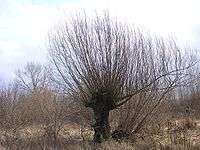Withy

A withy or withe is a strong flexible willow stem - typically used in thatching and for gardening.
Several species and hybrid cultivars of willows (often known as osiers) are grown for withy production; typical species include Salix acutifolia, Salix daphnoides, Salix × mollissima, Salix purpurea, Salix triandra, and Salix viminalis.[1]
The term is also sometimes used to describe any type of flexible rod used in rural crafts such as hazel or ash.
Withies traditionally serve to mark minor tidal channels in UK harbours and estuaries. In many places they remain in use as of 2015 and are often marked on navigation charts. At high tide the tops of a line of withies stuck in the mud on one or both sides of a channel will show above water to indicate where the deeper water lies. Note the images of international navigation-chart symbols for withies (port and starboard).


Places such as Wythenshawe and Withy Grove (both in Manchester) take their names from the willow woods and groves that grew there in earlier times. The Somerset Levels remain the only area in the UK growing basket willow commercially.
See also
| Look up withy in Wiktionary, the free dictionary. |
- The Bitter Withy, a folk song
- Coppicing
- Fascine
- Willow Man, a sculpture in England
References and external links
- ↑ Meikle, R. D. (1984). Willows and Poplars of Great Britain and Ireland. BSBI Handbook No. 4. ISBN 0-901158-07-0.